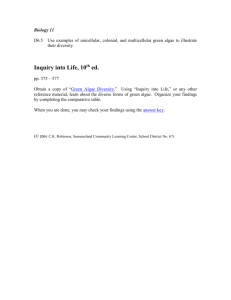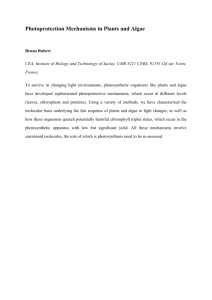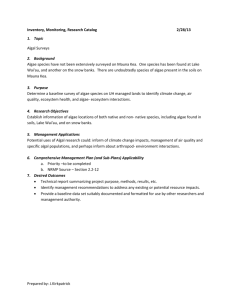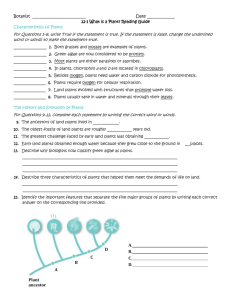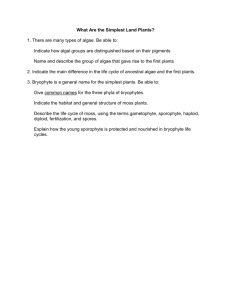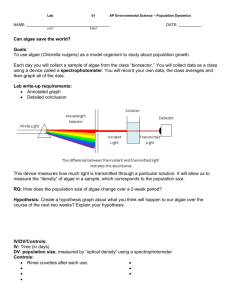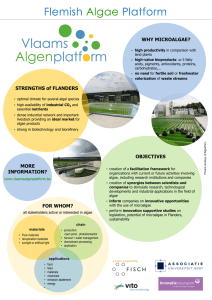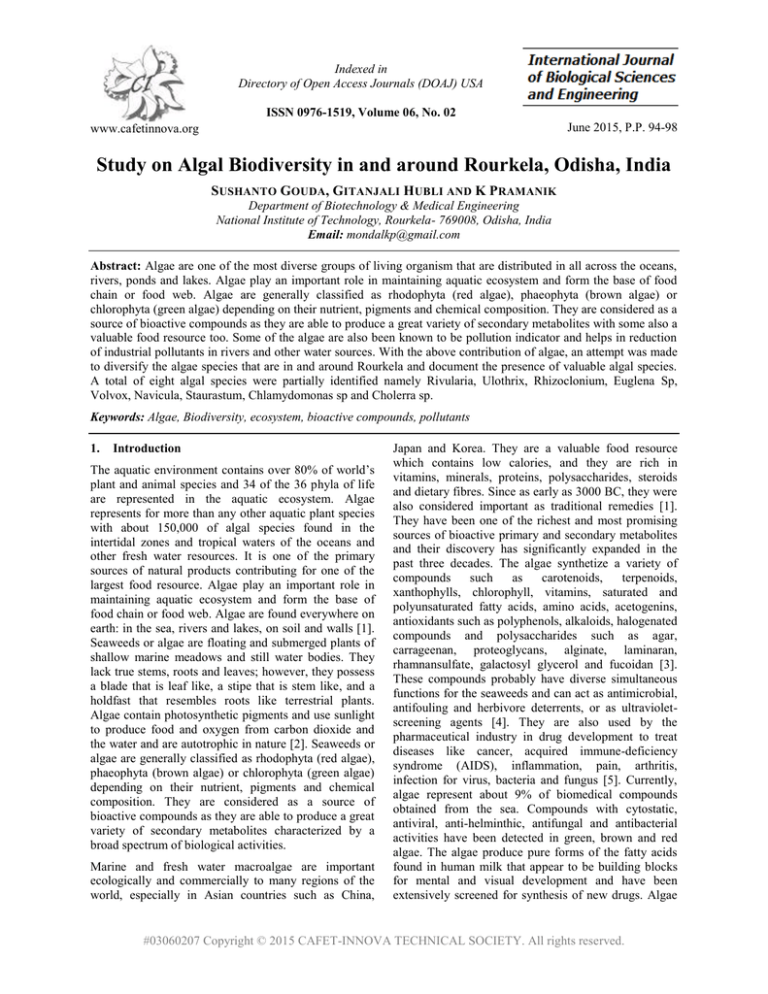
Indexed in
Directory of Open Access Journals (DOAJ) USA
ISSN 0976-1519, Volume 06, No. 02
June 2015, P.P. 94-98
www.cafetinnova.org
Study on Algal Biodiversity in and around Rourkela, Odisha, India
SUSHANTO GOUDA, GITANJALI HUBLI AND K P RAMANIK
Department of Biotechnology & Medical Engineering
National Institute of Technology, Rourkela- 769008, Odisha, India
Email: mondalkp@gmail.com
Abstract: Algae are one of the most diverse groups of living organism that are distributed in all across the oceans,
rivers, ponds and lakes. Algae play an important role in maintaining aquatic ecosystem and form the base of food
chain or food web. Algae are generally classified as rhodophyta (red algae), phaeophyta (brown algae) or
chlorophyta (green algae) depending on their nutrient, pigments and chemical composition. They are considered as a
source of bioactive compounds as they are able to produce a great variety of secondary metabolites with some also a
valuable food resource too. Some of the algae are also been known to be pollution indicator and helps in reduction
of industrial pollutants in rivers and other water sources. With the above contribution of algae, an attempt was made
to diversify the algae species that are in and around Rourkela and document the presence of valuable algal species.
A total of eight algal species were partially identified namely Rivularia, Ulothrix, Rhizoclonium, Euglena Sp,
Volvox, Navicula, Staurastum, Chlamydomonas sp and Cholerra sp.
Keywords: Algae, Biodiversity, ecosystem, bioactive compounds, pollutants
1.
Introduction
The aquatic environment contains over 80% of world’s
plant and animal species and 34 of the 36 phyla of life
are represented in the aquatic ecosystem. Algae
represents for more than any other aquatic plant species
with about 150,000 of algal species found in the
intertidal zones and tropical waters of the oceans and
other fresh water resources. It is one of the primary
sources of natural products contributing for one of the
largest food resource. Algae play an important role in
maintaining aquatic ecosystem and form the base of
food chain or food web. Algae are found everywhere on
earth: in the sea, rivers and lakes, on soil and walls [1].
Seaweeds or algae are floating and submerged plants of
shallow marine meadows and still water bodies. They
lack true stems, roots and leaves; however, they possess
a blade that is leaf like, a stipe that is stem like, and a
holdfast that resembles roots like terrestrial plants.
Algae contain photosynthetic pigments and use sunlight
to produce food and oxygen from carbon dioxide and
the water and are autotrophic in nature [2]. Seaweeds or
algae are generally classified as rhodophyta (red algae),
phaeophyta (brown algae) or chlorophyta (green algae)
depending on their nutrient, pigments and chemical
composition. They are considered as a source of
bioactive compounds as they are able to produce a great
variety of secondary metabolites characterized by a
broad spectrum of biological activities.
Marine and fresh water macroalgae are important
ecologically and commercially to many regions of the
world, especially in Asian countries such as China,
Japan and Korea. They are a valuable food resource
which contains low calories, and they are rich in
vitamins, minerals, proteins, polysaccharides, steroids
and dietary fibres. Since as early as 3000 BC, they were
also considered important as traditional remedies [1].
They have been one of the richest and most promising
sources of bioactive primary and secondary metabolites
and their discovery has significantly expanded in the
past three decades. The algae synthetize a variety of
compounds
such
as
carotenoids,
terpenoids,
xanthophylls, chlorophyll, vitamins, saturated and
polyunsaturated fatty acids, amino acids, acetogenins,
antioxidants such as polyphenols, alkaloids, halogenated
compounds and polysaccharides such as agar,
carrageenan, proteoglycans, alginate, laminaran,
rhamnansulfate, galactosyl glycerol and fucoidan [3].
These compounds probably have diverse simultaneous
functions for the seaweeds and can act as antimicrobial,
antifouling and herbivore deterrents, or as ultravioletscreening agents [4]. They are also used by the
pharmaceutical industry in drug development to treat
diseases like cancer, acquired immune-deficiency
syndrome (AIDS), inflammation, pain, arthritis,
infection for virus, bacteria and fungus [5]. Currently,
algae represent about 9% of biomedical compounds
obtained from the sea. Compounds with cytostatic,
antiviral, anti-helminthic, antifungal and antibacterial
activities have been detected in green, brown and red
algae. The algae produce pure forms of the fatty acids
found in human milk that appear to be building blocks
for mental and visual development and have been
extensively screened for synthesis of new drugs. Algae
#03060207 Copyright © 2015 CAFET-INNOVA TECHNICAL SOCIETY. All rights reserved.
SUSHANTO GOUDA, G ITANJALI HUBLI AND K P RAMANIK
are also known to be comparatively sensitive to
chemicals. Their ecological position at the base of the
aquatic food chain and their essential roles in nitrogen
and phosphorus cycling are critical to aquatic
ecosystems [6].
In the recent years, algae flourished in water polluted
with organic wastes play an important part in “selfpurification of water bodies”. Algae have become
significant organisms for biological purification of
wastewater as they are able to accumulate plant
nutrients, heavy metals, pesticides, organic and
inorganic toxic substances and radioactive matters in
their cells/bodies [7, 8]. Bio-indicator organisms can be
used to identify and qualify the effects of pollutants on
the environment and their period of persistence.
Approximately 46 taxa have been announced as
representatives of the clean water algae. The ecosystem
approach to water quality assessment also includes
diatom species, several flagellates and certain green and
blue-green algae. Some of the common algal species
extensively used as bio-indicator are Stigeoclonium
tenue, Nitzschia palea, Gomphonema parvulum,
Cocconei chamaesiphon and Navicula accomoda. The
flagellates Chromulina rosanoffi, Mallomonas caudata,
the green algae Ulothrix zonata and Microspora
amoena are also reported as oligosaprobic zone
organisms [2, 3, 9]. Algae are also able to accumulate
highly toxic substances such as selenium, zinc and
arsenic in their cells and/or bodies thus eliminating such
substances from aquatic environments.Considering all
these abilities of algae to purify the polluted waters
of many types, it is worth to emphasize that algal
technology in wastewater treatment systems are
expected to get even more common in future years.
Thus, an approach was undertaken to study the algal
diversity in the water bodies in and around Rourkela,
Odisha owing to their great biological activities.
2.
Materials and Methods
use [10]. Identification of the algae samples were
carried out mostly through microscopically by
Compound Optical Microscope Leica DM -750
Germany attached with ICC 50-HD camera. Standard
monographs of George 1976, Lund, 1960, Belcher and
Swale, 1978 was used as reference.
Fig 1: Mandira Dam
Fig 2: Mandira Dam
2.1. Collection of Samples
Algal samples were collected in sterile plastic bags from
different water bodies in and around the city of
Rourkela. Rourkela, one of India's most important
industrial cities, is located in Sundargarh district of
western Odisha. The city lies between Latitude 22°25'N
and Longitude 84°00'E in the heart of the mineral belt
of the state. The sites of collection were Koel River,
Mandira Dam and Lotus point Pond (NIT).
2.2. Identification and preservation of Algae Samples
Samples collected from different sites were washed
thoroughly with running tap water for removal of any
form of solid materials. Samples were then preserved
using standard preservative of Iodine solution and 4%
formalin and were stored in glass containers for further
95
Fig 3: Lotus Point (NIT)
International Journal of Biological Sciences and Engineering
ISSN 0976-1519, Vol. 06, No. 02, June 2015, pp. 94-98
96
Study on Algal Biodiversity in and around Rourkela, Odisha, India
Fig 4: Water bodies in Rourkela
Fig 5: Map of Rourkela City
3.
Result and Discussion
The study in different water bodies of Rourkela showed
a rich diversity of filamentous algae belonging to
various classes. The sites were also contains a large
amount of micro-algae, flagellated phytoplankton’s and
diatoms. Some of the algae that were identified during
the course of the study are discussed below;
i.
Rivularia– The algal species of Rivularia was
collected from Koel during the period of June. It
belongs to the family Rivulariaceae and is a group
of complex cyanobacteria according to traditional
classification [14] and of the order Nostocales.
Cells form trichomes with a wide or narrow
mucilaginous sheath. Trichomes are usually
unbranched or falsely branched (initiated at a
heterocyst or between two vegetative cells).
Specialised nitrogen-fixing cells (heterocysts) and
spore cells (akinetes) may be present. Reproduction
mainly by hormogonia or hormocysts [11, 12, 13,
14].
ii. Ulothrix – Ulothrix belonging to the order
Ulotrichales was collected from Koel River
(Jhirpani) and is best known filamentous alga of
this order. They are unbranched simple filaments
with mostly cylindrical cells containing a single
band-like chloroplast similar to that in the
Chlorococcales. Most species are attached when
young, but become free-floating later [11, 12, 13].
iii. Rhizoclonium– Rhizoclonium was collected from
the rock bed of Mandira dam over Brahmani River.
They belong to Cladophorales which are also
known as Siphoncladales. They are repeatedly
branched filaments, cylindrical cells and thick
walls. Chloroplast parietal and net-like in young,
healthy specimens, but sometimes appearing as
many small disks. Often the cell walls are very
thick and the filaments frequently carry many
diatom epiphytes etc. [11, 12, 13].
iv. Euglena- Euglena is a genus of unicellular
flagellate Protists and of family Euglenophyceae.
Species of Euglena are found in fresh and salt
waters. They are often abundant in quiet, inland
waters, where they may bloom in numbers
sufficient to colour the surface of ponds and ditches
green (E. viridis) or red (E. sanguinea). Most
species of Euglena have photosynthesizing
chloroplasts within the body of the cell, which
enable them to feed by autotrophy, like plants.
However, they can also take nourishment
heterotrophically, like animals. Euglena found in
the lotus point was attached on rocks and were
orange and golden colour in pigmentation [11, 12,
13].
v. Navicula sp.: This species was not abundant, but
often present in small numbers together with other
diatoms and blue greens in soil and water samples.
When collected, the cells were pail olive in colour
and contained numerous oil droplets, along with
two large oil globules to each side of the nuclear
bridge typical for the representatives of this genus.
They are unicellular and can exist as colonies, their
cell wall comprises of Silica called frustle. Cell
length 27.5-82.5 μm, cell width 7.5-17.5 μm (in the
broadest central part). They are found in Jhirpani
Koel River [15].
vi. Staurastrum sp- Staurastrum sp belongs to the
family Desmidiaceae. With cell body of (28-44µm
long and 30-44 µm wide, cells at the tip of filament
are nearly elliptical. The upper margin is more
convex than lower margin. Each margin is with a
spine projecting. Most are unicellular and are found
divided into two compartments separated by a
narrow bridge no flagella. Sexual reproduction
occurs through a process of conjugation [16].
vii. Chlamydomonas sp. They belong to the family
Chlamydomonadaceae. Unicellular cells swim with
two flagella both equal in length and generally oval
in shape. Their Cell wall contains cellulosic
polysaccharides, two anteriorly inserted whiplash
flagella and contractile vacuoles at the bases of
flagella are unique features to identify this genus.
The anterior portion of the chloroplast contains fat
droplets. Reproduces by both asexual and sexual
mean sexual reproduction goes through Zoospores,
Palmella stage, Alpanospores and Hypnospores.
Sexual reproduction is mainly through isogamy,
International Journal of Biological Sciences and Engineering
ISSN 0976-1519, Vol. 06, No. 02, June 2015, pp. 94-98
SUSHANTO GOUDA, G ITANJALI HUBLI AND K P RAMANIK
anisogamy or oogamy. They were mostly found in
Lotus Point Pond during the course of study [14,
17].
viii. Chlorella sp. It is of the family Chlorellaceae.
Small round or oval cells which divide about 2 to
10 μm in diameter. They are non-motile (without
flagella) and multiply rapidly. Their presence in the
water gives it a homogenous olive or grass green
colour. They do not produce motile spores for
reproduction. Only vegetative reproduction has
been noticed among them. They were found in all
three water bodies [18].
ix. Volvox: Volvox is of family the Volvocaceae was
found in Lotus point Pond in a sparse population.
Volvocanes/ Volvox have peculiar characteristics
of forming planar or spherical colonies varying
from 4 to 32 cells, each cell may have two flagella
and the entire colony moves in coordination both
sexual and asexual reproduction occurs. Sexual
reproduction occurs by oogametes and sperms from
female and male colonies [19].
Fig 9: Staurastrum sp
Fig 10: Chlorella sp
Fig 6: Rivularia
Fig 11: Navicula Sp
Fig 7: Rhizoclonium sp.
Fig 12: Chlamydomonas sp
Fig 8: Euglena sp
Fig: Volvox sp
International Journal of Biological Sciences and Engineering
ISSN 0976-1519, Vol. 06, No. 02, June 2015, pp. 94-98
97
98
4.
Study on Algal Biodiversity in and around Rourkela, Odisha, India
Conclusion
Algae are an integral part of the ecosystem that serves
for various purposes such as fooder, photosynthesis and
also as waste management. The areas around National
Institute of Technology, Rourkela has several water
sources consisting of both stagnant and free flowing and
therefore, a rich source of various forms of filamentous
algae. Rourkela being the industrial hub of Odisha
leaves several forms of pollutants in to the water bodies.
Therefore study on such algae can play an important
role in ecological management and also in keeping a
check on the pollution level in the water bodies.
5.
Acknowledgement
The authors are thankful to the administrative section of
NIT, Rourkela for their kind support and permission to
carryout sampling in the nearby water bodies.
References
[1] A. Ianora, M. Boersma, R. Casotti, A. Fontana, J.
Harder, F. Hoffmann, H. Pavia, P. Potin, S.A.
Poulet and G. Toth, “New trends in marine
chemical ecology”, Estuaries Coasts, 29, 531–551.,
2006.
[2] R.K. Jha and X. Zi-rong, “Biomedical compounds
from marine organisms”, Mar. Drugs, 2, 123–146.,
2004.
[3] S. Verdisson, M. Couderchet and G. Vernet,
“Effects of procymidone, fludioxonil and
pyrimethanil on two non-target aquatic plants”,
Chemosphere, 44, 467–474., 2001.
[4] L.F.A. Cynthia, S.F. Heloina, R.M.L. Gedson,
A.M. Camila, “Bioactivities from Marine Algae of
the Genus Gracilaria. A review”, Int. J. Mol. Sci.,
12, 4550-4573., 2011.
[5] V. Vadlapudi, “Antioxidant activities of marine
algae: A review”, Research Signpost 37/661: 2,
189-203., 2012.
[6] N.S. Kalesh and S.M. Nair “The accumulation
levels of heavy metals (Ni, Cr, Sr, & Ag) in marine
algae from Southwest Coast of India”
Toxicological & Env Chem, 87: 2, 135-146., 2005.
[7] M.T. Alp, O. Ozbay and M.A. Sungur,
“Determination of heavy metal levels in sediment
and macroalgae (Ulva sp. and Enteromorpha sp.)
on the Mersin Coast”, Ekoloji 21, 82, 47-55., 2012.
[8] K.M. MacKenthun, “Radioactive wastes”. Chapter
8. İn the practice of water pollution biology. U.S.
Dept. Interior, Fed. Water Pol. Contr. Admin., Div.
of Tech. Support. U.S. Printing Office., 1969.
[9] E. Berrendero, P. Elvira and M. Pilar, “Genetic and
morphological characterization of Rivularia and
Calothrix (Nostocales, Cyanobacteria) from
running water”, Int. J. Sys and Evol. Microbiology,
58, 447–460., 2008.
[10] F. Chen, D.G. Ramesh, L. Jing, L. Zhengwen, “A
comparison of the size distribution of the
filamentous green alga Ulothrix in Daphnia guts
and lake water from Lake Taihu, China”, J.
Plankton Res, 33:8, 1274–1283., 2011.
[11] E.A. George, “A guide to algal keys (excluding sea
weeds)”, British Phycolagical J, 11:1, 49-85., 1976.
[12] J.W.G. Lund, “The microscopical examination of
fresh water- Proceedings of the Society for Water
Treatment and Exatuinatian”, 9: 2, 109-144., 1960.
[13] H. Belcher and E. Swale,” A beginner's guide to
freshwater algae”, 1-48., 1978.
[14] H.A. Thakur and K.H. Behere, “Study of
filamentous algal biodiversity at Gangapur Dam
Nashik District, (M.S), India”, The 12th World Lake
conference, 456-461., 2008.
[15] H.K. Gwang, A.K. Tatyana and H.K. Sung, “Notes
on freshwater and terrestrial algae from NyÅlesund, Svalbard (high Arctic sea area)”, J, Env.
Bio, 29: 4, 485-491., 2008.
[16] A.A. Gontcharov, B.A. Marin, M.A. Melkonian,
“Molecular phylogeny of conjugating green algae
(Zygnemophyceae, Streptophyta) inferred from
SSU rDNA sequence comparisons", J. Mol.
Evol. 56:1, 89–104., 2003.
[17] A.J. Smit, “Medicinal and pharmaceutical uses of
seaweed natural products: A review”, J. Appl.
Phycol. 16, 245–262., 2004.
[18] S. Nakano, H. Takekoshi and M. Nakano,
“Chlorella
(Chlorella
pyrenoidosa)
Supplementation decreases dioxin and increases
immunoglobulin a concentrations in breast milk”, J.
Med Food 10 :1, 134–42., 2007
[19] M.D. Herron and R.E. Michod, “Evolution of
complexity in the Volvocine algae: Transitions in
individuality through Darwin's eye”, Evolution, 62,
436–451., 2008.
International Journal of Biological Sciences and Engineering
ISSN 0976-1519, Vol. 06, No. 02, June 2015, pp. 94-98

